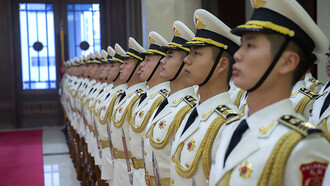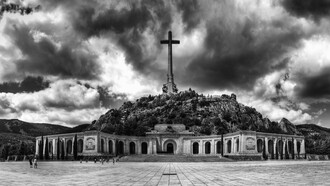The future of the international system is a debate amongst many scholars, academics, economists, policymakers, governments and citizens around the globe. It is important because shifts in the system have significant ramifications for global trade, national security, resource management, transport and logistics and humanity's collective success in tackling significant global challenges like climate change. Additionally, interactions between states have consequences for future security and economic prosperity. Luis da Vinha, a Lecturer in International Relations at Flinders University, pointed out he is not a futurist and that the most practical way to begin contemplating what the next few decades hold is by looking to the works of scholars such as Stephen Walt, Graeme Allison, John Mearsheimer and John Ikenberry. As a starting point, it is also integral to understand some key terms. For example, what is meant by ‘international system’, and how is this distinguishable from ‘international order’, and ‘balance of power.’ These distinctions are crucial to engage in meaningful discussions about what is to come.
What is an international system?
The concept of the international system dates back to the Peace of Westphalia in Europe in 1648 when it was declared: that each sovereign state could do as it pleased within its borders without interference from another.1 Since then, states have engaged with one another in an environment known as the international system.1 Some states within the system hold more power than others. These states may view international rules as non-binding. 1
The system is often described as anarchic because no single or central authority is in charge.1 There is no set world leader, international parliament, judiciary system, or police force that ensures all State actors behave in a particular way.1 Though a range of international organisations exist, including the United Nations (UN), the International Monetary Fund (IMF), the World Bank and the World Trade Organisation (WTO), there is not and has never been a central governing body or authority that monitors or polices the way states behave and relate to one another.
From a realist perspective, states act in their best interests of themselves and seek to govern the people contained within their borders based on some shared, globally recognised principles.1 Security dilemmas occur over real or perceived conflict within the international system.1 The balance of power in the international system seeks to prevent anyone state from having too much power and becoming too dominant. 1
What is the current international system?
Our current international system is only a few centuries old and came about following the end of the Cold War. There has been much debate regarding what type of international system presently exists. Some argue we are operating within a unipolar environment, while others argue that with China's rising influence, we are progressing towards a multipolar system.2
Distinguishing the international system and international order
An international system differs from an international order. While an international system can be described as a ‘plurality of states that regularly interact, so that the well-being of each depends on the conduct of others and such that each needs to take the likely conduct of others into account in deciding what to do’, international order is what occurs ‘when we have a pattern of activity between and among states that sustains the basic goals of the society states, which include: [(i) goals of all social life (security, agreement, property); (ii) preservation of State system of states; (iii) maintaining the independence of the separate units; (iv) preserving peace’.3 As such, multiple orders can exist within an established international system.
The importance of the balance of power in the international system
According to Klos and Kobrynski, "changes in the international system contribute mainly to the balance of power"4 globally and the distribution of power in the system is its most important feature. All states are responsible for the balance of power. In the international system, less powerful states with limited influence may become objects rather than actors. 4 Further, power within the international system is solely increased by one state at the expense of the power of another state. And states generally seek to maintain or increase their power. 4 Waltz (1999) highlights that although the international system is anarchic, the Great Powers are responsible for its structure.5 The distribution of power (i.e., polarity classification) provides the basis for patterns of interaction amongst states and determines the placement of a state within the relative power hierarchy.
Factors that influence the structure of the international system
Power balance and the structural integrity of an international-system is a product of several factors. It is typically a consequence of history and is shaped and refined over time through reinforcement by the status quo.4 Polish professor, M. Sulek, created a method of evaluating and quantifying power which helps assess and determine the current balance of power and make projections about what will unfold in the next three decades.
Sulek’s model integrates the newest international relations and security studies, including physics and cybernetics.4 His evaluation suggests that total power within the international system includes several forms of power, including idle power, availability of power, operating power, coordination power and assurance power.4 According to Professor Sulek, ‘availability power is called the total power and the coordinating power is the military power’.4 In predicting and analysing the likely future international system and balance of power, Sulek developed the following equations to determine the availability of power for a political entity and the coordination of power:
Pd = D0,652 * L 0,217 * p2019
Pm = W0,652 * S 0,217 * p2019
Pd represents total power, Pm represents military power using the number of soldiers on active duty, D represents gross domestic product L represents the population, p represents the surface area (the area of the territory), S represents the number of soldiers and W represents military spending.4 Evaluating these factors is useful for anyone interested in gazing into a crystal ball to understand the likely international system in 2050.
Reference
1 Jones Lee (2020) The International System Education and Training accessed on 13 December 2021.
2 The Dialogue (2016) The Unipolar World accessed online 16 December 2021.
Ikenberry J (2019) After Victory: Institutions, Strategic Restraint, and the Rebuilding of Order after Major Wars Princeton University Press.
3 Massachusetts Institution of Technology (MIT) (2021) Global Society Lecture Notes accessed online 16 December 2021.
4 Klos P and Kobrynski R (2013) The International Balance of Power in the Year 2050 (Security Implications) National Defence University Poland.
5 Waltz KN (1999)Realist Thought and Neorealist Theory Journal of International Affairs (New York), 44(1), 1990–04–01, 21–37.
Mazarr M, Priebe M, Radin A and Cevallos A (2016) Understanding the Current International Order RAND Corporation.
Mearsheimer J (2017) John Mearsheimer: We are Moving to a Multipolar World with Three Great Powers Valdi Club accessed 18 December 2021.
Mearsheimer J (2019) Bound to Fail: the Rise and Fall of the Liberal International Order International Security 43(4), 7-50.
Sun M (2014) Balance of Power Theory in Today’s International System e-international relations accessed online 19 December 2021.
US Department of State (2021) U.S China Joint Glasgow Declaration on Enhancing Climate Action in the 2020s Office of the Spokesperson Press Release 10 November 2021 accessed online 13 December 2021.
Victor D (2019) International Politics of Climate Change United Nations accessed online 17 December 2021.















